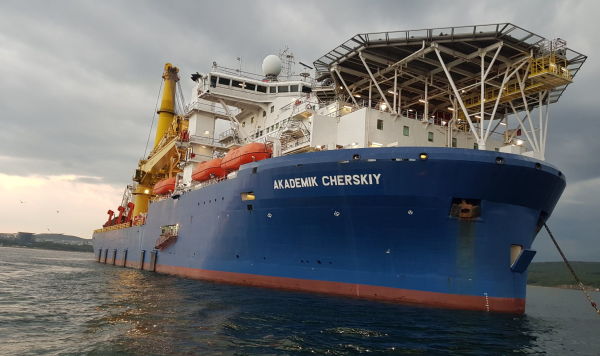Russia milks COVID19 pandemic for all its worth to break the US sanctions targeting to shield the European energy market from the Kremlin’s concentrated control and to diversify natural gas supplies to the European market.
In December 2019, the United States imposed sanctions on Nord Stream 2, demanding the companies involved to stop pipelining. As a result, Swiss Allseas, Gazprom’s yearslong partner, stopped the gas pipeline. In response to the sanctions, Gazprom started looking for alternative ways to dodge the sanctions. As a result, the Akademik Cherskiy derrick pipe laying vessel departed from Nakhodka on February 10. The pipe layer was built in China and bought by Russian Nazpromflot in 2015. It was supposed to be used as part of work at Sakhalin-3 project.
The vessel hauls off and changes destination ports every now and then, thus reflecting Russia’s fear and attempt to hide the real target on itinerary.
Singapore and the port of Maputo in southern Mozambique were the last destination ports reported. Now it is heading to the South African port of Cape Town, where it’s due to arrive around March 27. The frequent change of the destination port is obviously intended to block the way of hot US sanctions against it. The vessel is highly unlikely to stop at Cape Town. Its course is expected to run along the west coast of Africa.

The vessel’s mission is so important that Moscow ordered the Baltic Fleet ships to guard it in some sections of its route: Yaroslav the Wise, a patrol boat, Viktor Konetsky, a tug boat, and Yelnya, a tanker were moving along the pipelayer’s path. However, the need to cross the Strait of Gibraltar, probably, made it reconsider the original plan.
That was influenced by the fact that in July 2019, the Gibraltar authorities detained Grace 1 oil tanker of Iran. The vessel was released in a month and a half after actual exchange: Grace 1 tanker (renamed Adrian Darya 1) was detained at the request of the United States over suspicions of oil supplies to Syria, bypassing EU sanctions.
Thus, amid US sanctions against pipe-laying vessels constructing the Nord Stream-2, the risks of being detained by the Gibraltar authorities forced Moscow to pave the pipe layer’s way along the longest route. However, the ship’s new route leaves room for stopping at three points. Akademik Cherskiy might be detained on the ground of quarantine, facilitated by COVID19 in Europe.
Nord Stream-2 construction has already been newly rescheduled to be finished, and the Russian side will do its best to try to keep on this new schedule.
The first step will be to deliver the vessel to the place of pipe loading, where it should undergo preventive maintenance, preparation and repair. Moreover, it remains unknown whether the vessel was modernized in Nakhodka to work with large diameter pipes. According to data as of January 1, 2020, the vessel was not ready to operate as a pipe layer, since it did not have the necessary welding and installation equipment.
Akademik Cherskiy’s pipeline laying speed is about 1–1.5 km of pipes per day. Consequently, it will take it about five months to complete the work after arriving in the Baltic Sea.
Russian vessel’s arrival in the Baltic Sea challenges the US and EU interests as it enables the completion and commissioning of a gas pipeline that will increase the share of Russian gas in the European market and set stage for politicizing energy supplies.
If Moscow succeeds in bringing Akademik Cherskiy to the Baltic Sea, that will hurt Donald Trump’s public image, showing his inability to confront the Kremlin in guarding the interests of national producers and markets. Before 2020 elections, that could change the candidate for US energy companies’ shoo-in.




